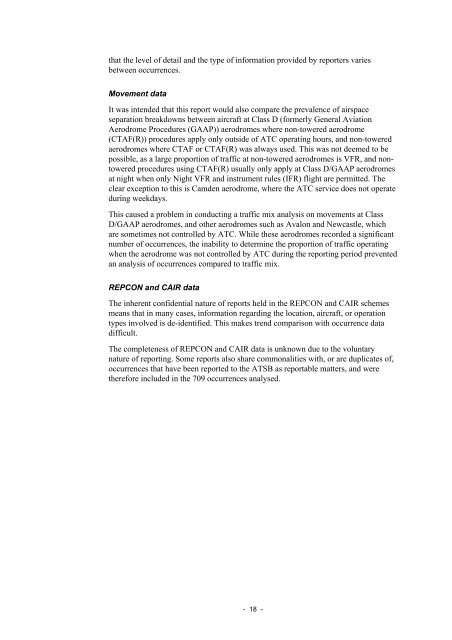Safety in the vicinity of non-towered aerodromes - Australian ...
Safety in the vicinity of non-towered aerodromes - Australian ...
Safety in the vicinity of non-towered aerodromes - Australian ...
You also want an ePaper? Increase the reach of your titles
YUMPU automatically turns print PDFs into web optimized ePapers that Google loves.
that <strong>the</strong> level <strong>of</strong> detail and <strong>the</strong> type <strong>of</strong> <strong>in</strong>formation provided by reporters varies<br />
between occurrences.<br />
Movement data<br />
It was <strong>in</strong>tended that this report would also compare <strong>the</strong> prevalence <strong>of</strong> airspace<br />
separation breakdowns between aircraft at Class D (formerly General Aviation<br />
Aerodrome Procedures (GAAP)) <strong>aerodromes</strong> where <strong>non</strong>-<strong>towered</strong> aerodrome<br />
(CTAF(R)) procedures apply only outside <strong>of</strong> ATC operat<strong>in</strong>g hours, and <strong>non</strong>-<strong>towered</strong><br />
<strong>aerodromes</strong> where CTAF or CTAF(R) was always used. This was not deemed to be<br />
possible, as a large proportion <strong>of</strong> traffic at <strong>non</strong>-<strong>towered</strong> <strong>aerodromes</strong> is VFR, and <strong>non</strong><strong>towered</strong><br />
procedures us<strong>in</strong>g CTAF(R) usually only apply at Class D/GAAP <strong>aerodromes</strong><br />
at night when only Night VFR and <strong>in</strong>strument rules (IFR) flight are permitted. The<br />
clear exception to this is Camden aerodrome, where <strong>the</strong> ATC service does not operate<br />
dur<strong>in</strong>g weekdays.<br />
This caused a problem <strong>in</strong> conduct<strong>in</strong>g a traffic mix analysis on movements at Class<br />
D/GAAP <strong>aerodromes</strong>, and o<strong>the</strong>r <strong>aerodromes</strong> such as Avalon and Newcastle, which<br />
are sometimes not controlled by ATC. While <strong>the</strong>se <strong>aerodromes</strong> recorded a significant<br />
number <strong>of</strong> occurrences, <strong>the</strong> <strong>in</strong>ability to determ<strong>in</strong>e <strong>the</strong> proportion <strong>of</strong> traffic operat<strong>in</strong>g<br />
when <strong>the</strong> aerodrome was not controlled by ATC dur<strong>in</strong>g <strong>the</strong> report<strong>in</strong>g period prevented<br />
an analysis <strong>of</strong> occurrences compared to traffic mix.<br />
REPCON and CAIR data<br />
The <strong>in</strong>herent confidential nature <strong>of</strong> reports held <strong>in</strong> <strong>the</strong> REPCON and CAIR schemes<br />
means that <strong>in</strong> many cases, <strong>in</strong>formation regard<strong>in</strong>g <strong>the</strong> location, aircraft, or operation<br />
types <strong>in</strong>volved is de-identified. This makes trend comparison with occurrence data<br />
difficult.<br />
The completeness <strong>of</strong> REPCON and CAIR data is unknown due to <strong>the</strong> voluntary<br />
nature <strong>of</strong> report<strong>in</strong>g. Some reports also share commonalities with, or are duplicates <strong>of</strong>,<br />
occurrences that have been reported to <strong>the</strong> ATSB as reportable matters, and were<br />
<strong>the</strong>refore <strong>in</strong>cluded <strong>in</strong> <strong>the</strong> 709 occurrences analysed.<br />
- 18 -
















